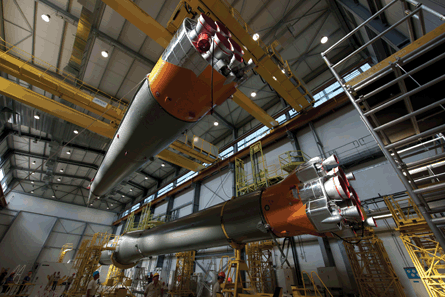At the European Space Agency (ESA), fingers remain crossed as the countdown continues towards its much-anticipated Soyuz launch on 20 October.
Not only will the three-stage ST-B rocket will be making its first-ever flight from ESA's launch centre in Kourou, French Guiana, its payload will be the first two satellites for Europe's Galileo navigation constellation.
Final assembly began on 12 September, following electrical and mechanical tests in August.
The horizontal integration is taking place inside a purpose-built building at the spaceport, with roll-out to the launch pad planned for 14 October.
 |
|---|
© ESA Soyuz assembly is carried out at a dedicated facility in Kourou |
A second Soyuz launch, carrying two more Galileo spacecraft, is to follow in December.
Then, thanks to cash freed up by some €500 million ($673 million) in cost savings, ESA will embark on a fast-track effort to purchase and launch enough satellites to provide near-global coverage by the end of 2014. This is some seven years behind the original plan, but well ahead of expectations at the beginning of this year.
Some of the new satellites may prove more capable than existing designs, so the full extent of coverage available remains to be seen. Ultimately, the complete Galileo plan calls for 27 spacecraft and three orbiting spares by 2019.
European Commission vice-president for industry Antonio Tajani has been Galileo's champion in Brussels, and has described the October launch as of "historical importance", as Europe seeks to match or exceed US capability in with a technology that will bring significant safety, operational and economic benefits to European citizens.
VEGA EN ROUTE
Meanwhile, to top off what ESA director general Jean-Jacques Dordain has called a "year of launchers", components of ESA's first Vega rocket this week left Avio's factory in Colleferro, near Rome, for sea transport to Kourou in anticipation of the type's maiden flight in December 2011 or January 2012.
The medium-lift Soyuz and light category Vega will complement ESA's heavy lift Ariane 5s, to provide a fully flexible range of launch options at Kourou.
Vega, whose first stage is one of the world's biggest carbonfibre single-piece structures, is designed to launch satellites of up to 1.5 tonnes into 700km (435 mile) polar orbits.
As French Guiana is much closer to the equator than Soyuz's normal launch site in Baikonur, Kazakhstan, added boost from the Earth's spin will nearly double its maximum payload to geostationary transfer orbit (GTO) to 3 tonnes.
Ariane 5 can lift 10 tonnes to GTO, though ESA member governments are thought to be moving towards the approval of a mid-life upgrade to increase its payload capacity.
A longer-term project is also under way to develop a high-thrust cryogenic engine, that could form the basis of ESA's next-generation launcher.
It will not fly until about 2025, but is intended to provide a medium-lift capability in a modular design, with a re-ignitable upper stage and options for strap-on solid propellant boosters offering extra thrust.
Source: Flight International






















